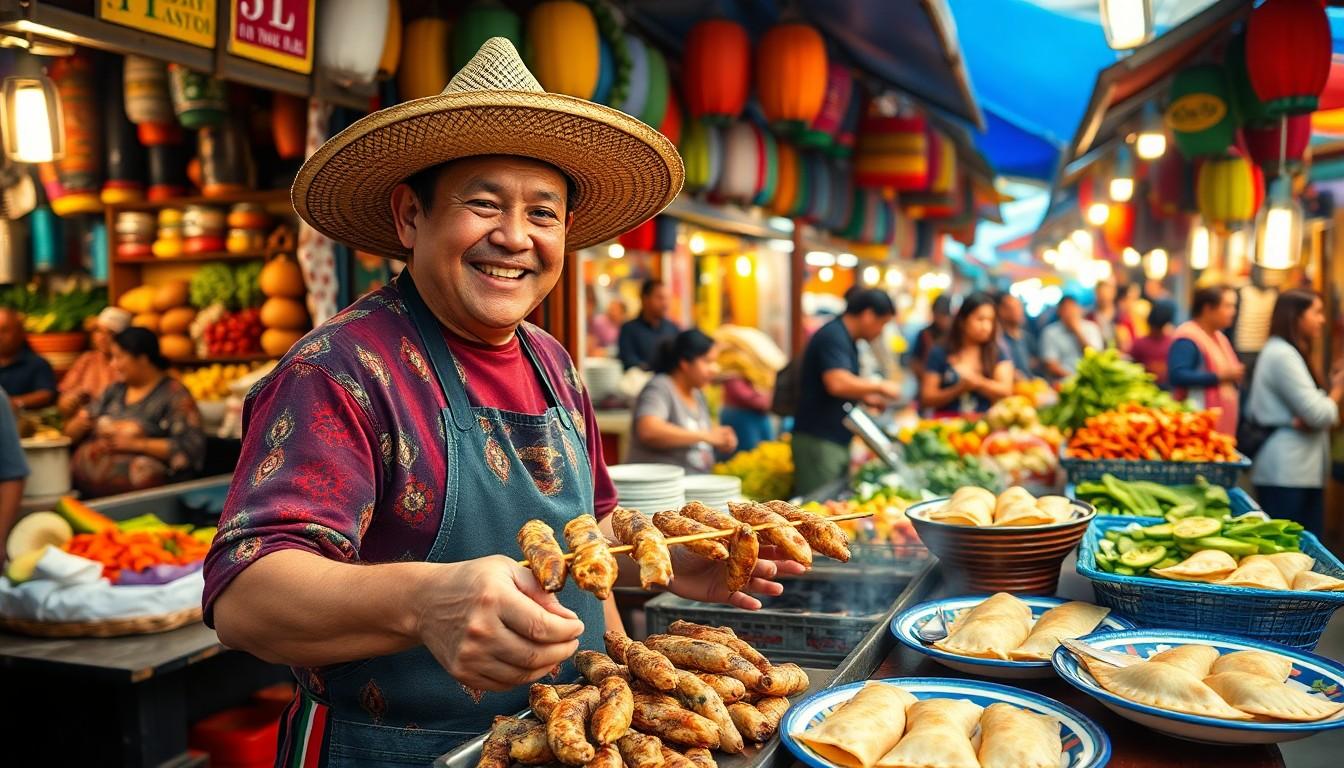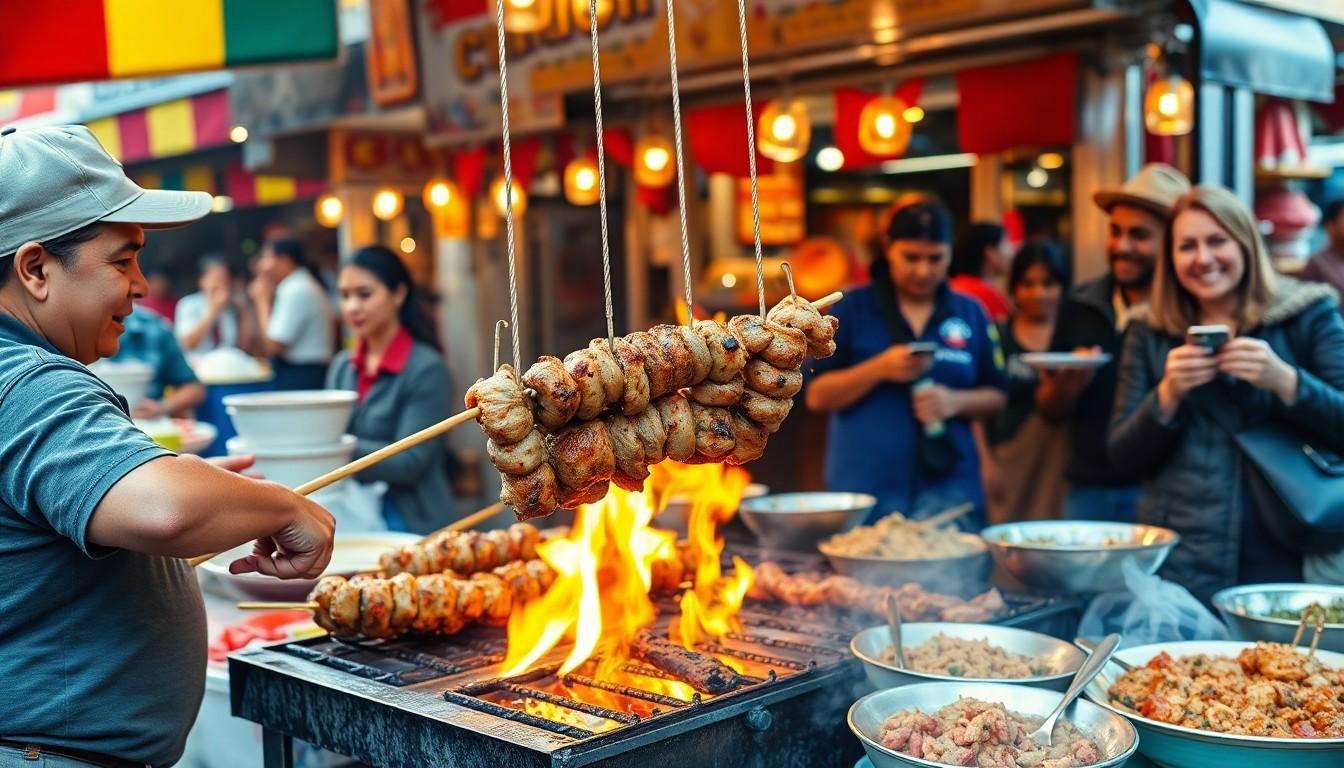Physical Address
304 North Cardinal St.
Dorchester Center, MA 02124

Peruvian street food is a culinary adventure waiting to happen. Imagine strolling through vibrant markets, the air filled with mouthwatering aromas that make your stomach grumble louder than a hungry llama. From savory anticuchos to crispy empanadas, each bite tells a story of rich culture and tradition.
Peruvian street food represents a diverse and flavorful aspect of the nation’s cuisine. Popular dishes showcase local ingredients and traditional cooking methods. Anticuchos, skewers of marinated meat, often feature beef heart seasoned with spices. Empanadas, filled pastry dough, provide savory options, typically including ground meat and vegetables.
Visitors can encounter ceviche, a dish made of fresh fish cured in lime juice, frequently served with sweet potatoes. Various markets offer unique snack choices, such as papa a la huancaina, boiled potatoes complemented by a creamy cheese sauce. Hot dogs, known locally as “picantes,” present an exciting twist with toppings like jalapeños and sauces.
Regional specialties also enhance the street food experience. From Arequipa comes rocoto relleno, a spicy stuffed pepper, while Lima showcases causa, a layered potato dish. Each dish reflects Peru’s geographical diversity and rich history.
Street vendors often skillfully prepare food right before customers’ eyes, emphasizing freshness and quality. The vibrant atmosphere of bustling markets encourages community interaction and a sense of cultural pride. Food represents a connection, with families gathering around delightful meals.
Peruvian street food creates a dynamic gastronomic adventure that excites locals and tourists alike. Each bite reveals a blend of indigenous influences, African, Asian, and European flavors, which creates a melting pot of tastes. Knowing where to find these culinary delights, whether in urban neighborhoods or countryside festivals, enhances the overall experience.

Peruvian street food features a variety of iconic dishes that reflect the nation’s culinary heritage. Each dish offers a unique taste and experience.
Anticuchos consist of skewered and grilled marinated meat, often beef heart, seasoned with spices and vinegar. Vendors heat them on open flames, enhancing their smoky flavor. Traditionally served with a side of potatoes and aji sauce, anticuchos are a favorite in street food markets. The aroma draws locals and tourists alike, making them a must-try for anyone exploring Peruvian cuisine.
Ceviche is a celebrated dish made from fresh fish cured in lime juice, mixed with onions, cilantro, and chili peppers. This refreshing dish typically showcases the richness of Peru’s coastal waters. Served cold, ceviche embodies the essence of freshness. Street vendors often prepare it right before serving, ensuring optimal taste. It’s a staple at both casual eateries and upscale restaurants.
Lomo Saltado combines marinated beef stir-fried with onions, tomatoes, and Peruvian spices. This flavorful dish merges influences from Chinese cooking with traditional Peruvian ingredients. Served with rice and fried potatoes, lomo saltado offers a hearty meal that appeals to many. Street vendors dish it out quickly, maintaining an authentic taste and texture. Each plate encapsulates the vibrant culinary scene of Peru.
Peruvian street food showcases an array of ingredients and flavors that reflect its rich culinary heritage. Fresh produce, diverse spices, and unique cooking methods create a vibrant gastronomic experience.
Cumin, a staple in Peruvian cuisine, adds warmth and earthiness to many dishes. Aji amarillo, a yellow chili pepper, delivers both color and a fruity heat that enhances the flavors of anticuchos and ceviche. Garlic often complements meats, providing depth and aroma. Oregano provides herbal notes, commonly found in marinades and sauces. Each spice contributes to the distinct flavor profiles, making every bite a celebration of Peruvian culture.
Regional variations highlight Peru’s vast culinary diversity. In the Andes, quinoa is frequently incorporated into dishes, showcasing local grains. Coastal areas use fresh fish, evident in ceviche, which varies by region with different types of seafood. In Arequipa, rocoto relleno features stuffed spicy peppers, while Lima offers causa, a layered potato dish. Each region’s unique ingredients and traditional cooking methods create an exceptional street food tapestry across Peru.
Peru’s street food culture thrives through vibrant markets and bustling vendors. This culinary scene offers both tradition and innovation, with dishes that tell the stories of their creators.
Individuals behind the stalls often share their recipes passed down through generations. Each vendor’s story adds a personal touch, making the food more than just a meal. Families may specialize in specific dishes, such as empanadas or anticuchos, showcasing their heritage. Passion fuels these artisans, evidenced by the care they put into their cooking. Pride radiates from them as they serve locals and tourists alike, establishing connections with their customers via shared culinary experiences. Additionally, vendors adapt their offerings based on seasonal ingredients, ensuring freshness and quality.
Street food in Peru fosters community bonding and social connection. Markets act as gathering spots where friends and families meet to enjoy meals together. Visitors engage with locals over shared plates, enhancing cultural exchange. Street food reflects economic accessibility, allowing diverse demographics to enjoy quality cuisine. Festivals and celebrations often feature food stalls, emphasizing the role of street food in traditional events. Culinary enjoyment fosters pride in local ingredients, deepening residents’ appreciation for their culinary heritage. Community spirit thrives in this lively atmosphere, as shared food experiences enrich lives and strengthen bonds.
Familiarity with local practices enhances the overall street food experience. Travelers should keep a few essential tips in mind for a safe and delicious tasting journey.
Hygiene plays a critical role in enjoying street food. Observe the vendor’s cleanliness, including the cooking area and utensils. Choose vendors that prepare food fresh in front of customers, as this often indicates higher quality. Inspecting the food’s cooking process can provide peace of mind. Avoid dishes that have been sitting out for extended periods, as they may pose health risks. Freshness is key, especially with seafood dishes like ceviche.
Lima tops the list for the best street food locations, with its vibrant neighborhoods and bustling markets. Try the district of Miraflores, known for its variety of food stalls offering classic dishes. Barranco, another lively area, features unique vendors specializing in traditional snacks. Street fairs and festivals often showcase local delicacies, providing a memorable tasting experience. Arequipa presents the opportunity to taste regional dishes, like rocoto relleno, in its famed markets. Finding these hotspots popular among locals ensures an authentic culinary adventure.
Peruvian street food offers an unforgettable culinary journey that captures the heart of the nation’s culture. Each dish tells a story of tradition and innovation reflecting the rich tapestry of flavors and ingredients unique to Peru. Whether savoring the smoky taste of anticuchos or the refreshing zing of ceviche, every bite is an exploration of Peru’s diverse heritage.
The vibrant markets and passionate vendors create an atmosphere that invites everyone to partake in this delicious experience. For those eager to dive into this culinary adventure, the streets of Lima and beyond promise a feast that celebrates both community and culture. Enjoying street food isn’t just about the flavors; it’s about connecting with the spirit of Peru.